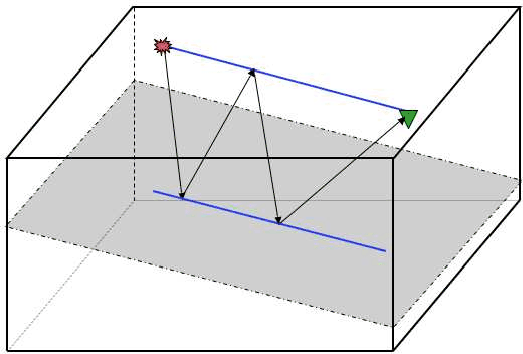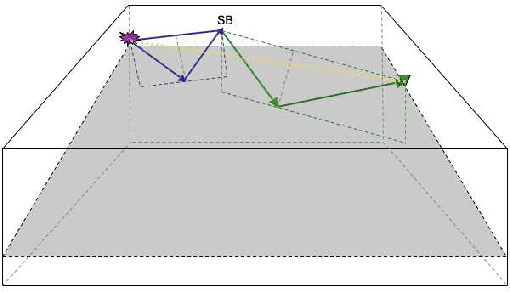|
|
|
|
 plane (recall that in my
convention the crossline direction is along the
plane (recall that in my
convention the crossline direction is along the
|
3d-mul-sktch2
Figure 3. Raypath for a 3D water-bottom multiple from a water-bottom dipping in the inline direction only. The multiple propagation is entirely contained in a vertical plane only when the source-receiver azimuth is along the inline direction. |

|
|---|---|
|
|
For all other source-receiver azimuths and for water-bottom with crossline dip, the multiple reflection path can no longer be considered a simple extension of the 2D case via a rotation of coordinates. The ray from the source to the reflector to the surface is contained in the plane normal to the reflector as required by Snell's law. On the other hand, the ray from the bounce point at the surface to the reflector to the receiver cannot be contained in the same plane since the surface is flat and therefore its normal is vertical. This reflection has to be contained in a vertical plane. This means that the surface bounce cannot lie in the line that joins the source and the receiver (see Figure 4). The coordinates of the bounce point at the surface, the coordinates of the reflection points on the water-bottom and the traveltime of the multiple can be computed with the equations given by ().
|
3d-mul-sktch3
Figure 4. Raypath for a 3D Water-bottom multiple from a water-bottom dipping in the crossline direction only. The multiple propagation is not entirely contained in one plane. The ray from the source to the reflector to the surface bounce (SB) define one plane while the ray from the surface bounce to the reflector to the receiver is contained in a different plane. |

|
|---|---|
|
|
Rather than attempting to derive convoluted equations for the residual moveout of the 3D multiples
in SODCIGs or ADCIGs that could never be used in any reasonably practical Radon kernel, I will
use the simpler equations for the flat water-bottom as I did for the 2D case in
Chapter ![]() . In order to analyze the mapping of a crossline-dipping water-bottom
multiple to image space, I will use a 3D prestack synthetic dataset provided by ExxonMobil.
. In order to analyze the mapping of a crossline-dipping water-bottom
multiple to image space, I will use a 3D prestack synthetic dataset provided by ExxonMobil.
|
|
|
|